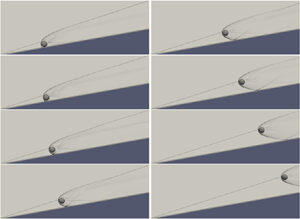Article contents
Dynamics of a spherical body shedding from a hypersonic ramp. Part 1. Inviscid flow
Published online by Cambridge University Press: 16 November 2020
Abstract

Numerical simulations are employed to investigate the dynamical separation of an initially stationary sphere from the surface of a two-dimensional ramp in hypersonic flow. We consider the inviscid limit, which is equivalent to assuming the sphere radius to be much larger than the ramp boundary-layer thickness; this assumption allows a range of Mach numbers and ramp angles to be explored efficiently. Of particular interest is determining how the shock-surfing phenomenon discovered by Laurence & Deiterding (J. Fluid Mech., vol. 676, 2011, pp. 396–431), in which a spherical body can stably oscillate about an oblique shock as it moves downstream, manifests itself in such a situation. First, the isolated interactions between a sphere and an oblique shock, and then between a sphere and an inviscid wall, are examined independently to elucidate relevant trends. Full trajectory predictions are subsequently performed using a decoupled model in which the shock and wall interactions are assumed to contribute independently to the aerodynamic forces. Three types of trajectories are found to be possible: surfing of the spherical body; initial expulsion outside the shock layer followed by re-entry and entrainment; or direct entrainment. At relatively low hypersonic Mach numbers, the latter two types of trajectories are predominant, but at higher Mach numbers ( $M\gtrsim 10$), surfing becomes possible over an increasingly wide range of ramp angles and downstream release locations. By reparameterizing the release location as the initial lateral distance of the sphere from the shock, good collapse of the transition boundary delineating surfing from ejection/re-entrainment over various Mach numbers and ramp angles is obtained.
$M\gtrsim 10$), surfing becomes possible over an increasingly wide range of ramp angles and downstream release locations. By reparameterizing the release location as the initial lateral distance of the sphere from the shock, good collapse of the transition boundary delineating surfing from ejection/re-entrainment over various Mach numbers and ramp angles is obtained.
JFM classification
- Type
- JFM Papers
- Information
- Copyright
- © The Author(s), 2020. Published by Cambridge University Press
References
REFERENCES
- 5
- Cited by





